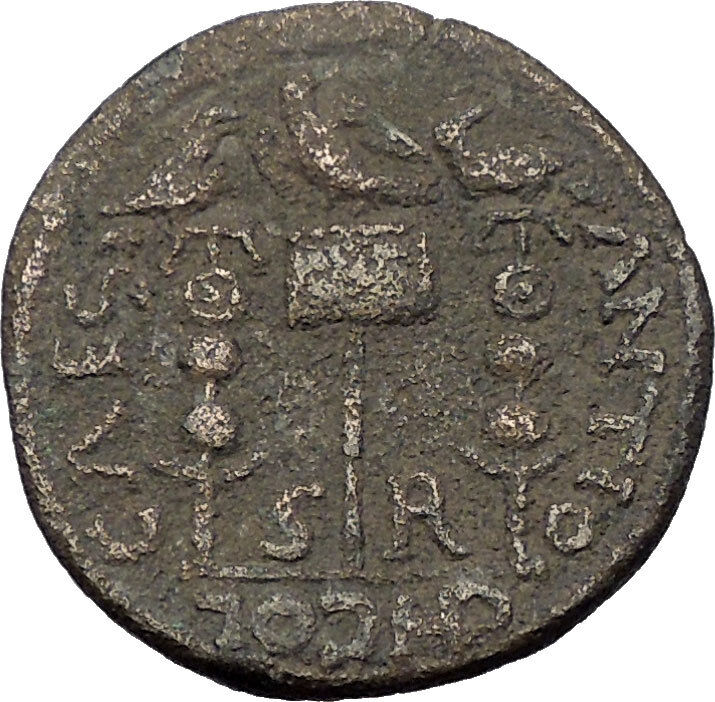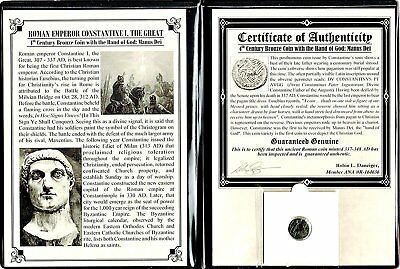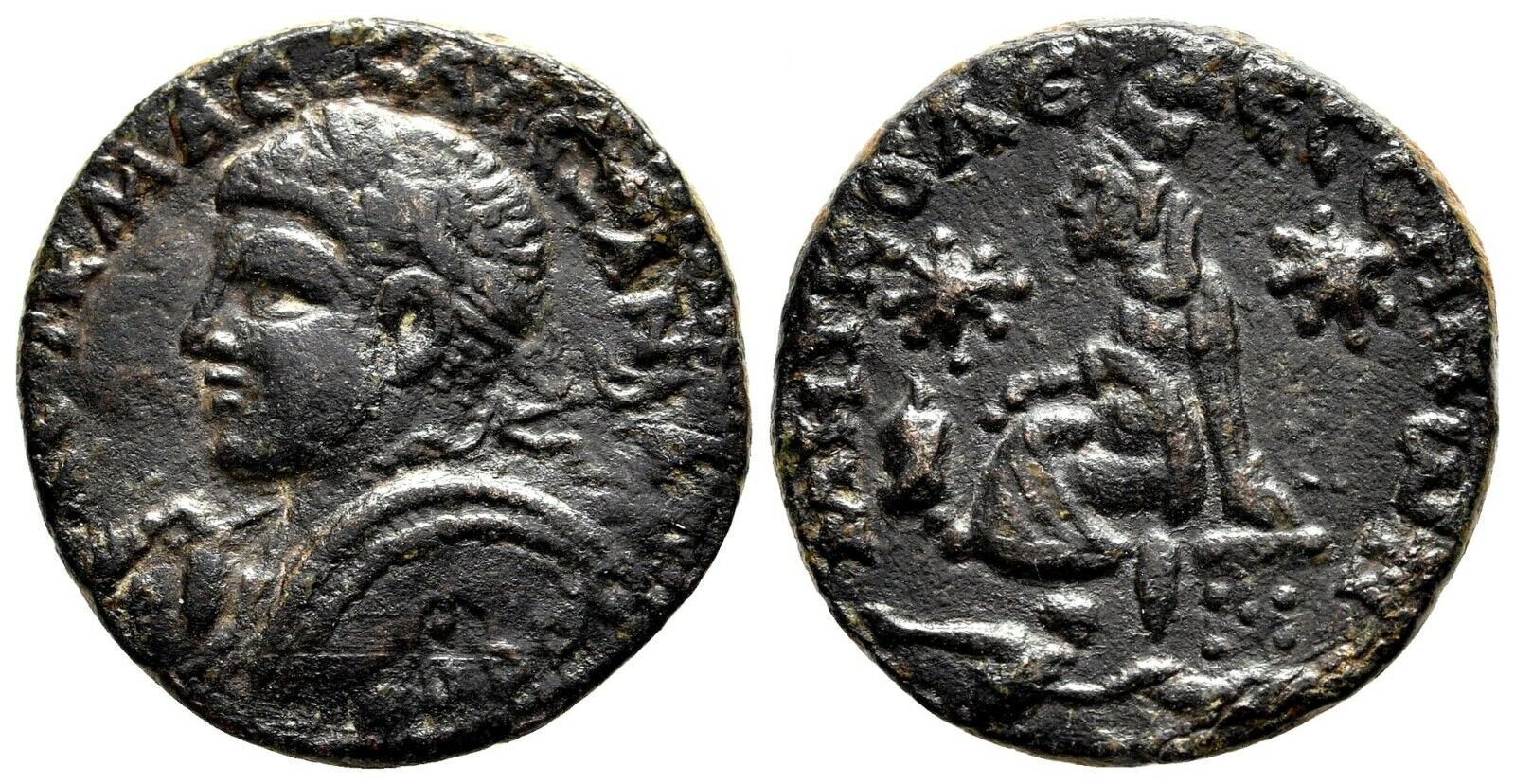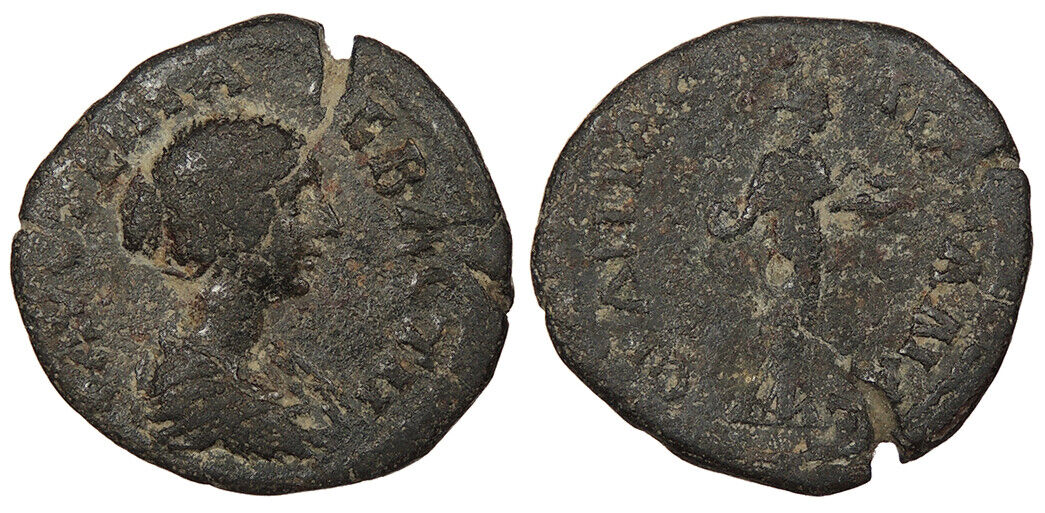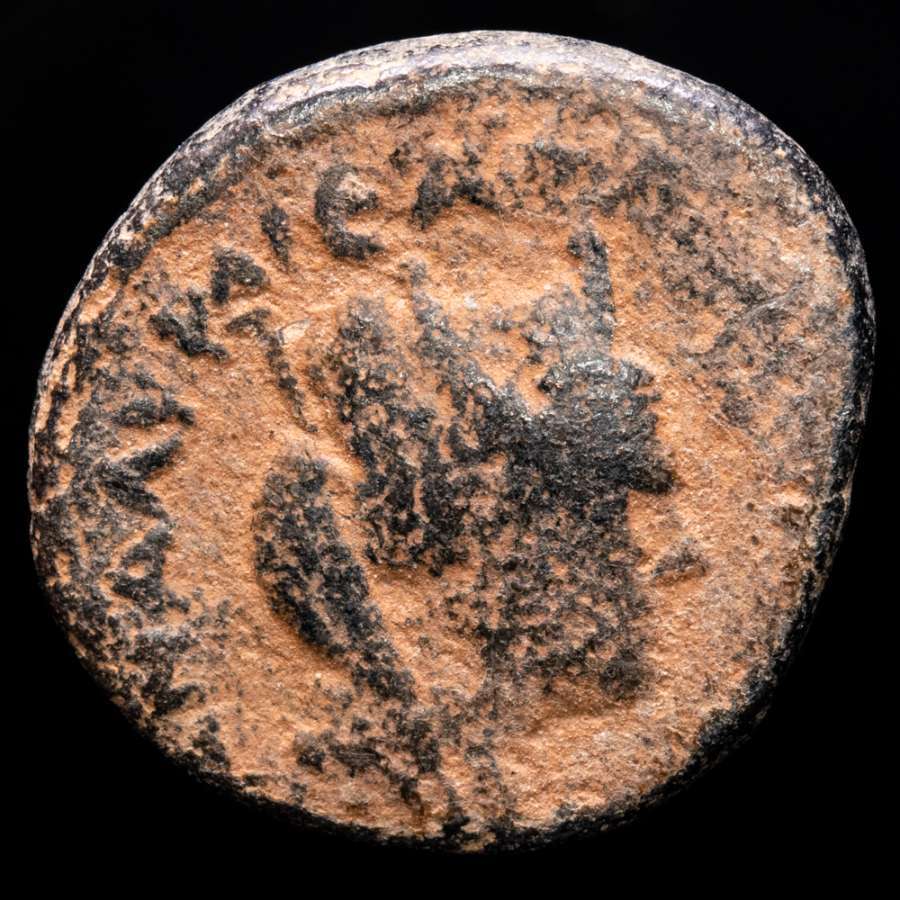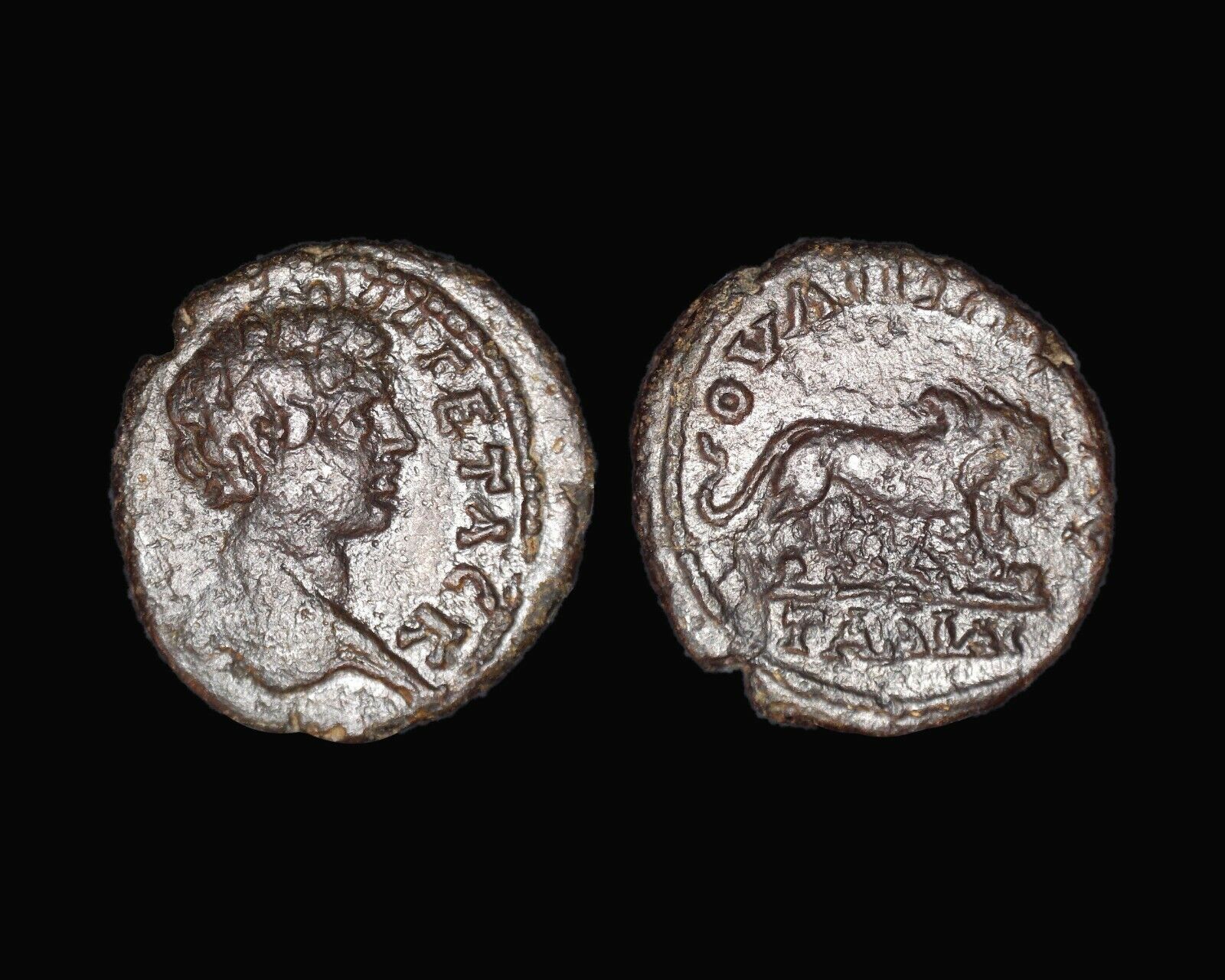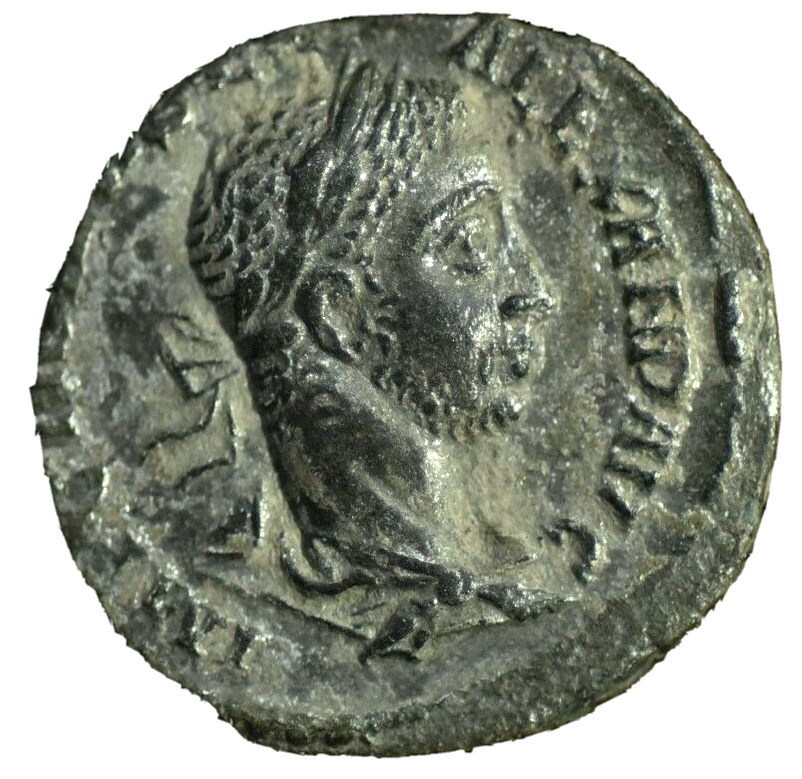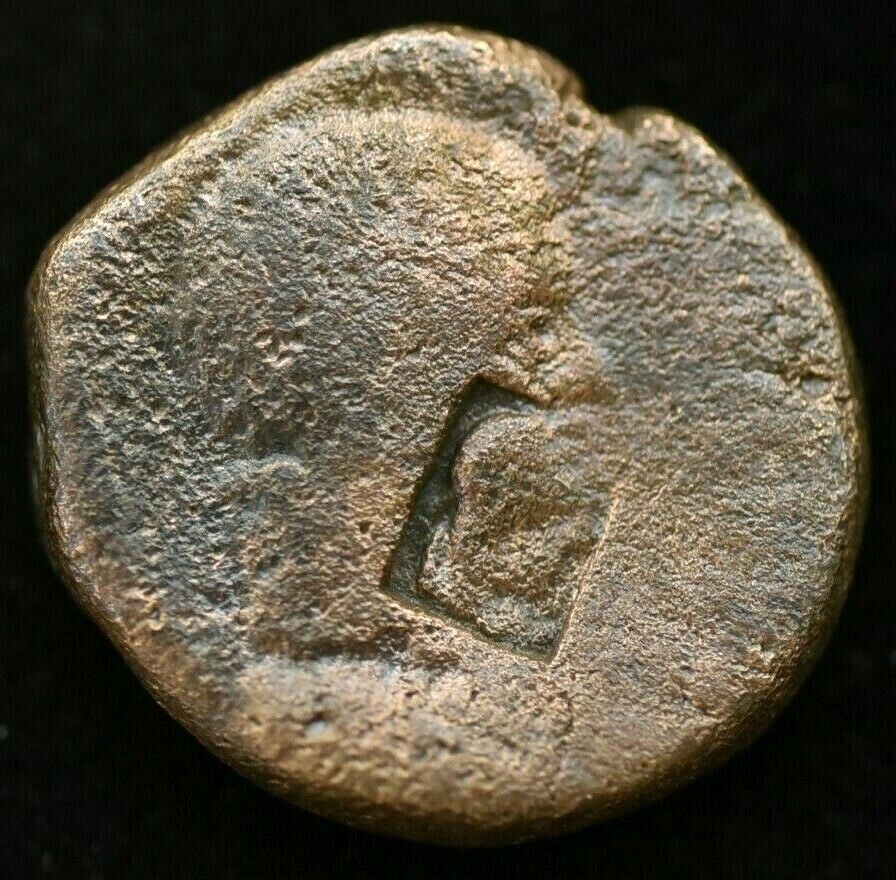-40%
PHILIP II 244AD Antioch Pisidia Legionary Eagle Standards Roman Coin i56581
$ 52.8
- Description
- Size Guide
Description
Item:i56581
Authentic Ancient Coin of:
Philip II
-
Roman Caesar
: 244-249 A.D. -
Bronze 26mm (9.46 grams)
of
Antioch in Pisidia
Radiate and cuirassed bust right.
CAES ANTIOCH COL, vexillum surmounted by eagle, between two legionary eagles, S-R to lower left and right of vexillum.
You are bidding on the exact item pictured, provided with a Certificate of Authenticity and Lifetime Guarantee of Authenticity.
The
vexillum
(
English pronunciation:
plural
vexilla
was a
flag
-like object used in the
Classical Era
of the
Roman Empire
. The word is itself a diminutive for the Latin word, velum, sail, which confirms the historical evidence (from coins and sculpture) that vexilla were literally "little sails" i.e. flag-like standards. In the vexillum the cloth was draped from a horizontal crossbar suspended from the staff; this is unlike most modern flags in which the 'hoist' of the cloth is attached directly to the vertical staff. The bearer of a vexillum was known as a
vexillarius
or
vexillifer
. Just as in the case of the regimental colors or flag of Western regiments, the vexillum was a treasured symbol of the military unit that it represented and it was closely defended in
combat
.
Nearly all of the present-day regions of
Italy
preserve the use of vexilla. Many Christian processional banners are in the vexillum form; usually these banners are termed
labara
(
Greek
:
λάβαρον
) after the standard adopted by the first Christian Roman emperor
Constantine I
which replaced the imperial eagle with the "
Chi-Rho
" symbol
☧
.
The term Vexillum is also used by the
Legion of Mary
as the term for its standard. A small version is used on the altar and a full size Vexillum leads processions.
Standards
Roman military standards. The standards with discs, or
signa
(
first three on left
) belong to
centuriae
of the legion (the image does not show the heads of the standards - whether spear-head or wreathed-palm). Note (
second from right
) the legion's
aquila
. The standard on the extreme right probably portrays the
She-wolf
(
lupa
) which fed
Romulus
, the legendary founder of Rome. (This was the emblem of
Legio VI Ferrata
, a legion then based in
Judaea
, a detachment of which is known to have fought in Dacia). Detail from Trajan's Column, Rome
Modern reenactors parade with replicas of various legionary standards. From left to right:
signum
(spear-head type), with four discs;
signum
(wreathed-palm type), with six discs;
imago
of ruling emperor; legionary
aquila
;
vexillum
of commander (
legatus
) of
Legio XXX Ulpia Victrix
, with embroidered name and emblem (
Capricorn
) of legion
Each tactical unit in the imperial army, from
centuria
upwards, had its own standard. This consisted of a pole with a variety of adornments that was borne by dedicated standard-bearers who normally held the rank of
duplicarius
. Military standards had the practical use of communicating to unit members where the main body of the unit was situated, so that they would not be separated, in the same way that modern tour-group guides use umbrellas or flags. But military standards were also invested with a mystical quality, representing the divine spirit (
genius
) of the unit and were revered as such (soldiers frequently prayed before their standards). The loss of a unit's standard to the enemy was considered a terrible stain on the unit's honour, which could only be fully expunged by its recovery.
The standard of a
centuria
was known as a
signum
, which was borne by the unit's
signifer
. It consisted of a pole topped by either an open palm of a human hand or by a spear-head. The open palm, it has been suggested, originated as a symbol of the
maniple
(
manipulus
= "handful"), the smallest tactical unit in the
Roman army of the mid-Republic
. The poles were adorned with two to six silver discs (the significance of which is uncertain). In addition, the pole would be adorned by a variety of cross-pieces (including, at bottom, a crescent-moon symbol and a tassel). The standard would also normally sport a cross-bar with tassels.
The standard of a Praetorian cohort or an auxiliary cohort or
ala
was known as a
vexillum
or banner. This was a square flag, normally red in colour, hanging from a crossbar on the top of the pole. Stitched on the flag would be the name of the unit and/or an image of a god. An exemplar found in Egypt bears an image of the goddess Victory on a red background. The
vexillum
was borne by a
vexillarius
. A legionary detachment (
vexillatio
) would also have its own
vexillum
. Finally, a
vexillum
traditionally marked the commander's position on the battlefield.
[194]
The exception to the red colour appears to have been the Praetorian Guard, whose
vexilla
, similar to their clothing, favoured a blue background.
From the time of
Marius
(consul 107 BC), the standard of all legions was the
aquila
("eagle"). The pole was surmounted by a sculpted eagle of solid gold, or at least gold-plated silver, carrying thunderbolts in its claws (representing
Jupiter
, the highest Roman god. Otherwise the pole was unadorned. No exemplar of a legionary eagle has ever been found (doubtless because any found in later centuries were melted down for their gold content). The eagle was borne by the
aquilifer
, the legion's most senior standard-bearer. So important were legionary eagles as symbols of Roman military prestige and power, that the imperial government would go to extraordinary lengths to recover those captured by the enemy. This would include launching full-scale invasions of the enemy's territory, sometimes decades after the eagles had been lost e.g. the expedition in 28 BC by
Marcus Licinius Crassus
against
Genucla
(Isaccea, near modern
Tulcea
, Rom., in the Danube delta region), a fortress of the
Getae
, to recover standards lost 33 years earlier by
Gaius Antonius
, an earlier
proconsul
of
Macedonia
. Or the campaigns of AD 14-17 to recover the three eagles lost by
Varus
in AD 6 in the
Teutoburg Forest
.
Under Augustus, it became the practice for legions to carry portraits (
imagines
) of the ruling emperor and his immediate family members. An
imago
was usually a bronze bust carried on top of a pole like a standard by an
imaginifer
.
From around the time of Hadrian (r. 117-38), some auxiliary
alae
adopted the dragon-standard (
draco
) commonly carried by Sarmatian cavalry squadrons. This was a long cloth wind-sock attached to an ornate sculpture of an open dragon's mouth. When the bearer (
draconarius
) was galloping, it would make a strong hissing-sound.
Decorations
The Roman army awarded a variety of individual decorations (
dona
) for valour to its legionaries.
Hasta pura
was a miniature spear;
phalerae
were large medal-like bronze or silver discs worn on the cuirass;
armillae
were bracelets worn on the wrist; and
torques
were worn round the neck, or on the cuirass. The highest awards were the
coronae
("crowns"), of which the most prestigious was the
corona civica
, a crown made oak-leaves awarded for saving the life of a fellow Roman citizen in battle. The most valuable award was the
corona muralis
, a crown made of gold awarded to the first man to scale an enemy rampart. This was awarded rarely, as such a man hardly ever survived.
There is no evidence that auxiliary common soldiers received individual decorations like legionaries, although auxiliary officers did. Instead, the whole regiment was honoured by a title reflecting the type of award e.g.
torquata
("awarded a torque") or
armillata
("awarded bracelets"). Some regiments would, in the course of time, accumulate a long list of titles and decorations e.g.
cohors I Brittonum Ulpia torquata pia fidelis c.R.
.
Antioch in Pisidia
– alternatively
Antiochia in Pisidia
or
Pisidian Antioch
(
Greek
:
Ἀντιόχεια τῆς Πισιδίας
) and in
Roman Empire
,
Latin
:
Antiochia Caesareia
or
Antiochia Caesarea
– is a city in the
Turkish Lakes Region
, which is at the crossroads of the
Mediterranean
,
Aegean
and Central
Anatolian
regions, and formerly on the border of
Pisidia
and
Phrygia
, hence also known as
Antiochia in Phrygia
. The site lies approximately 1 km northeast of
Yalvaç
, the modern town of
Isparta Province
. The city is on a hill with its highest point of 1236 m in the north.
Roman period
While the Hellenistic Kingdoms (the inheritors of
Alexander the Great
) were fighting each other and the Galatians,
Rome
became the most powerful state in Europe and started to follow a policy of expansion to the east. They invaded
Macedon
,
Thrace
, and the
Dardanelles
, and reaching
Phrygia
via
Magnesia
and Pisidia. They cowed the Galatians and according to the
treaty
signed in
Apamea
in 188 BC, they gave the land of Pisidia which they had got from
Antiochos III
, to their ally the
Pergamon
Kingdom which dominated the region.
Attalos III
, the last king of
Pergamon
, bequeathed his kingdom to Rome on his death in 133 BC
Aristonikos
who claimed Pergamon was defeated in 129, then Rome affected Anatolia with its well-developed, creative culture for centuries.
Although
Anatolia
was dominated by the
Roman Empire
as the
province of Asia
, Pisidia was given to the Kingdom of
Cappadocia
, which was an ally of Rome. During the following years, the authority gap which could not be filled by these kingdoms remote from central government, led to the rise of powerful pirate kingdoms, especially in
Cilicia
and Pisidia. The Romans were disturbed by these kingdoms and fought against them. Cilicia,
Pamphylia
,
Phrygia
and Pisida were freed from pirates and Roman rule was restored in 102 BC.
The geographical and strategical position of the region made it difficult to control the area and maintain constant peace. The
Homonadesians
, settled in the
Taurus Mountains
between
Attaleia
and
Ikonion
, caused problems for Rome.
Marcus Antonius
who had to control the roads connecting Pisidia to Pamphylia, charged his allied king
Amyntas
, King of Pisidia, to fight against Homonadesians, but Amyntas was killed during the struggle.
Then Rome started to colonize using military
legions
as a solution to the failure of the locally appointed governors. The Province of
Galatia
was established in 25 BC and Antioch became a part of it. To support the struggle against the Homonadesians logistically, the construction of a road called the
Via Sebaste
, the centre of which was Antioch, was started by the governor of the Province of Galatia,
Cornutus Arrutius Aquila
. The Via Sebaste was separated into two and directed to the southwest and southeast to surround the Homonadesians. Secondary connecting roads were built between these two roads. Rome by means of the Via Sebaste
P.Sulpicius Quirinius
brought an end to the Homonadesians problem in 3 BC, relocating survivors in different surrounding locations.
During the reign of
Augustus
, eight colonies were established in Pisidia, but only Antioch was honoured with the title of
Caesarea
and given the right of the
Ius Italicum
, maybe because of its strategic position. The city became an important Roman colony which rose to the position of a capital city with the name of "
Colonia
Caesarea
".
Hellenisation
became Latinisation during the Roman period and it was applied in Antioch best. The city was divided into seven quarters called "
vici
" all of which were founded on seven hills like in Rome. The formal language was
Latin
until the end of the 3rd century. The fertility of the land and the peace brought by
Augustus
(
Pax Romana
: Roman Peace) made it easier for the veterans as colonists in the area to have good relations and integration with the natives.
One of the three surviving copies of the
Res Gestae Divi Augusti
, the famous inscription recording the noble deeds of the Emperor Augustus was found in front of the Augusteum in Antioch. The original was carved on bronze tablets and exhibited in front of the
Mausoleum of Augustus
in
Rome
, but unfortunately has not survived. The Antioch copy on stone was written in Latin which is a sign of the importance of the city as a military and cultural base of Rome in Asia. (One of the copies, in
Greek
and
Latin
, is in
Ankara
, the other, in Greek, in Apollonia -Uluborlu).
Marcus Julius Philippus Severus
, also known as
Philippus II
,
Philip II
and
Philip the Younger
(238 – 249) was the son and heir of the
Roman Emperor
Philip the Arab
by his wife Roman Empress
Marcia Otacilia Severa
. According to numismatic evidence, he had a sister called Julia Severa or Severina, whom the ancient Roman sources do not mention.
When his father became emperor in 244 he was appointed
Caesar
. Philippus was
consul
in 247 and 248. His father was killed in battle by his successor
Decius
in 249. When news of this death reached Rome, he was murdered by the
Praetorian Guard
. He died in his mother's arms. When he died, he was eleven years old.
Frequently Asked Questions
How long until my order is shipped?:
Depending on the volume of sales, it may take up to 5 business days for shipment of your order after the receipt of payment.
How will I know when the order was shipped?:
After your order has shipped, you will be left positive feedback, and that date should be used as a basis of estimating an arrival date.
After you shipped the order, how long will the mail take?
USPS First Class mail takes about 3-5 business days to arrive in the U.S., international shipping times cannot be estimated as they vary from country to country. I am not responsible for any USPS delivery delays, especially for an international package.
What is a certificate of authenticity and what guarantees do you give that the item is authentic?
Each of the items sold here, is provided with a Certificate of Authenticity, and a Lifetime Guarantee of Authenticity, issued by a world-renowned numismatic and antique expert that has identified over 10000 ancient coins and has provided them with the same guarantee. You will be quite happy with what you get with the COA; a professional presentation of the coin, with all of the relevant information and a picture of the coin you saw in the listing.
Compared to other certification companies, the certificate of authenticity is a -50 value. So buy a coin today and own a piece of history, guaranteed.
Is there a money back guarantee?
I offer a 30 day unconditional money back guarantee. I stand behind my coins and would be willing to exchange your order for either store credit towards other coins, or refund, minus shipping expenses, within 30 days from the receipt of your order. My goal is to have the returning customers for a lifetime, and I am so sure in my coins, their authenticity, numismatic value and beauty, I can offer such a guarantee.
Is there a number I can call you with questions about my order?
You can contact me directly via ask seller a question and request my telephone number, or go to my About Me Page to get my contact information only in regards to items purchased on eBay.
When should I leave feedback?
Once you receive your order, please leave a positive. Please don't leave any negative feedbacks, as it happens many times that people rush to leave feedback before letting sufficient time for the order to arrive. Also, if you sent an email, make sure to check for my reply in your messages before claiming that you didn't receive a response. The matter of fact is that any issues can be resolved, as reputation is most important to me. My goal is to provide superior products and quality of service.
